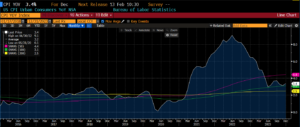Volatility in the commodities market: outlook for 2024
Understand what factors could generate volatility in the commodities market in 2024 and how to protect yourself from price changes.
Volatility in the commodities market occurs due to changes in supply and demand for these products. Factors such as wars, elections and the weather, for example, can trigger significant variations in prices, with repercussions both locally and globally.
In 2024, there are macroeconomic and geopolitical challenges that deserve attention, as they risk influencing commodity prices. In this sense, it is essential to rely on market intelligence analysis and hedging instruments to protect businesses from volatility.
With this in mind, we invited Luiz Carvalho, Senior Trader at hEDGEpoint Global Markets, to talk about the subject. You will understand:
- The macroeconomic and geopolitical trends of commodity volatility.
- The volatility behavior of the main commodities.
- The role of hEDGEpoint HUB risk management.
Enjoy the reading!
Macroeconomic and geopolitical trends of volatility in the commodities market
The macroeconomic scenario is one of the most complex, according to Carvalho. We need to look at the reality in the United States, after all, the country is one of the world’s main commodity producers:
“Surprisingly, the US labor market has been quite resilient: the unemployment rate is around 3.7%. In turn, the non-farm payroll reached all-time highs, even after a year marked by interest rate rises of over 5%”, Carvalho points out.
The high growth in US interest rates has allowed inflation to be controlled, which has stabilized at around 3.5% over the last six months. However, the pressure for interest rate cuts has only just begun. In 2024, a total cut of 150 basis points in interest rates is expected over the course of the year, but efforts will continue to bring inflation down to the 2% target.
Evolution of the Consumer Price Index (CPI)

Source: U.S. Bureau of Labor Statistics
Regarding the geopolitical context, Carvalho points out that two tensions remain in 2024:
- War in Ukraine: there has been no recent progress towards a ceasefire. However, Ukraine has started exporting a lot of wheat and corn This is an extremely crucial measure to stabilize world supply and demand and help reduce price volatility and inflation.
- The Israel-Hamas conflict is on the radar of commodities market participants, with the risk of generating price volatility in sectors such as energy.
“In addition, there is the possibility of new conflicts in the Middle East, Asia (between China and Taiwan) and Eastern Europe. We should watch the situation in these regions closely,” says hEDGEpoint’s Senior Trader.
Understand the volatility behavior of the main commodities
Analyzing the volatility behavior of the main commodities in 2023 is essential for making better-informed decisions in 2024. Therefore, hEDGEpoint has looked at the most notable patterns that can generate important insights.
According to Carvalho, the grain market has a characteristic volatile behavior: every year, it starts off timidly and then intensifies. This happens mainly when the weather is crucial, between June and August. At the end of the year, there is a relief again.
“This pattern applies to corn, the soy complex and wheat. Coffee, on the other hand, had a more atypical year, with peaks of volatility in May and December. Oil, on the other hand, follows the geopolitical agenda,” says Luiz Carvalho.
Seasonality of soybean implied volatility

Source: U.S. Bureau of Labor Statistics
In 2024, hEDGEpoint predicts a good grain harvest in South America, driven by Argentina’s recovery in the soybean market. One of the reasons for this is the fact that El Niño has had a positive effect on rainfall in important producing areas. As a result, there will be a balance in supply in the Southern Hemisphere, even in the face of lower production in Brazil.
Which events generated the most volatility in the commodities market in 2023?
After consecutive months of rising interest rates in the United States and the withdrawal of money from companies and startups, banks’ balances were compromised. This was therefore the period of greatest volatility for commodities last year.
Just to give you an idea, the parent company of Silicon Valley Bank has filed for bankruptcy. UBS bought Credit Suisse to avoid bankruptcy and the collapse of the Swiss banking system. In this context, the FED intervened to protect all depositors, which stopped the cascading effect on the economy.

“In 2023, the outbreak of the conflict between Israel and Hamas caused the second most volatile moment in the commodities market. The escalation of the war to different regions will depend on the motivations of all the parties involved in relation to a possible ceasefire”, explains Carvalho.
As a result, the macroeconomy will continue to be unstable in 2024.
hEDGEpoint HUB: discover our risk management platform
Knowing macroeconomic and geopolitical trends, as well as the behavior of commodity prices, makes all the difference when it comes to protecting yourself from volatility. At hEDGEpoint HUB, you have the resources to gain an in-depth understanding of all the dynamics that can impact this market.
This is hEDGEpoint’s educational platform, perfect for those who want to start managing risks in the commodities market. Here you’ll find data analysis, market intelligence reports and insights that enable you to trade commodities and hedge more assertively.
Adapted to different levels of expertise, hEDGEpoint HUB turns risks into opportunities. The best thing is that everyone has access to a free 30-day trial. Log in now and check it out!






